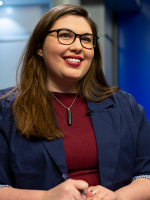Before Jill Franken became the volunteer state president for AARP South Dakota, she was the Public Health Director for the City of Sioux Falls. That made her the head of Falls Community Health, a federally qualified health center. Franken says half of the patients there are uninsured and she saw the struggles they have.
“They started out working and oftentimes they became unemployed because their health care issues became just so difficult for them to manage while being employed,” says Franken.
“That's when I got extremely passionate about it when I saw people really falling through the cracks from an access perspective. They could come to our clinic and they could be seen, but the second that they perhaps got an unfortunate diagnosis–let’s just say breast cancer for example–it was almost as if they were like, ‘Well, what am I going to do about this? Why would I even want to know that I have breast cancer, because I don’t have the ability to do anything about it. I can’t afford the surgery it might take. I can’t afford the medications if I have to go under, like, any chemo or hormone therapy.’ So, you know, those are the things that every day South Dakotans face all the time when they’re uninsured through a variety of circumstances.”
As the legislative session continues, lawmakers will decide whether to accept Governor Kristi Noem’s budget proposals to fund and staff Medicaid expansion or make adjustments. So far, advocacy organizations like the AARP South Dakota support the governor’s proposal.
The state estimates 52,000 South Dakotans will be eligible for healthcare under Medicaid expansion. Sarah Houska, who quit her job with the Department of Social Services to take care of a son with medical complications, remembers difficult conversations with people who had no healthcare coverage.
“I’ve had conversations, you know, almost daily in my last job with [people] who have chronic conditions and can’t ignore their healthcare cost like I’m able to right now,” says Houska. “And that’s such a heartbreaking conversation to say, ‘I know that you’re doing your best, and you’re doing everything you can in this moment, and it’s not because you’re lazy and you don’t want to go get a job. It’s because you can’t. ‘”
During a presentation for the Joint Appropriations Committee, state Medicaid Director Sarah Aker told lawmakers opportunities for preventative care could cost the state less in the long run.
“There’s many advocates that have been part of passing Medicaid Expansion as part of the ballot initiative. I think those individuals are really looking to help people get coverage and receive services for preventative things,” says Aker. “And that’s our hope too: that we’ll be preventing higher costs by creating an environment where individuals can access preventative services, prevent more hospitalizations, and try to prevent more –or, I’d say avoid those higher healthcare expenditures.”
The state must submit its plan for Medicaid expansion to the federal government by March 1. South Dakota’s expanded Medicaid takes effect on the first day of July.



